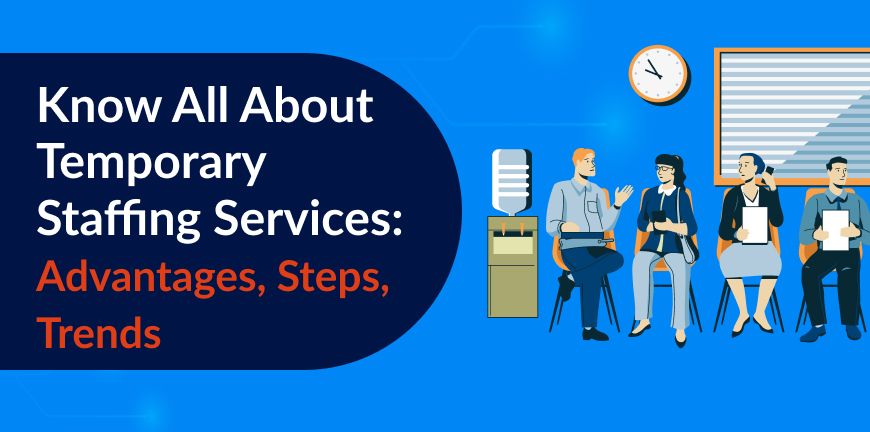
These 6 Things Will Change the Way You Approach Permanent Staffing
04/02/2022
Understanding 5 Benefits of Statutory Compliance
25/02/2022Temp or temporary staffing is a way to add more resources to the job market by hiring people for a certain time on a contractual basis. Temporary workers leave the organization once the project on which they worked is over.
A temporary worker often works for a client firm but is on the payroll of another firm, mostly a staffing agency. The whole arrangement is an agreement made between three parties, the client firm, the temp staff, and the staffing agency.  However, under certain circumstances, a Managed Service Provider is also involved. Temping is not just a tool meant for mass recruitment as there are instances when high-ranking people are also sourced as temporary applicants. The process of hiring temporary staff is as important, if not more, as hiring permanent employees.
However, under certain circumstances, a Managed Service Provider is also involved. Temping is not just a tool meant for mass recruitment as there are instances when high-ranking people are also sourced as temporary applicants. The process of hiring temporary staff is as important, if not more, as hiring permanent employees.
5 Steps Involved in Hiring Temporary Staff
The temporary staffing industry is huge, and it works in coordination with other businesses and processes. Here are the key steps involved in the temporary staff hiring process:
1. Setting up a Legally Binding Contract
Even if the temp staff is not on the payroll of the firm, an appropriate contract must be prepared as per the requirement. This contract must outline plainly the project duration, staff deliverables, compensation, termination clause, and more.
2. Balancing Merit and Cost
You may think that a firm will hire temp staff that entails a minimum cost to the company. This could be catastrophic as the product quality or service would deteriorate and the client could leave. To fulfill your seasonal requirements, you must employ temp staff that would be value for money. So, in addition to the cost, you must consider the qualifications of the staff such as certification, recommendations, and experience.
3. Knowing Manpower Needs
The temp staffing process is equally challenging as hiring new permanent staff. They are appointed to meet the demand produced by the additional workload. So, there must be full clarity about the required temp staff. It is not sufficient to choose the right staffing agency, as a firm must also take care of official aspects such as a standard offer letter summarizing the tasks of the temporary employee and the compensation offered.
4. Equality with Full-Time Employees
The temp staff is delivering a key service for your business in terms of effectively achieving a workload-based obligation or a seasonal surge in demand for your service. To incentivize them, they must be given benefits such as reimbursement and claims policies, leave policies, and retirement benefits among others.
5. Define Requirements Unambiguously
Since quality manpower is needed in a short span of time, it is particularly important to accurately declare the temp staff’s job description. The more detailed you are about the skills, experience, background, specifics of the suggested project, physical demands of the job and so on, the better are the odds of getting the right people.
3 Advantages of Using Temporary Staffing
Some of the most undeniable benefits of using temporary staff are as follows:
1. Lower Hiring Risks
If a temp worker stands out and is an asset to the team, you could hire them full-time. Having the ability to test employees ahead of time, to witness their skills, and to see how they work within the team, can considerably lower hiring risks.
2. Ideal Staffing Levels
Being short on staff is bad for business. When your employees go on leave or resign without serving notice and you are left with a smaller workforce, your productivity and the bottom line suffer. But being overstaffed to avoid these concerns is not good either. You will end up shelling more in payroll costs to get the work done.
3. Happier Employees
Happy employees are often more productive. If a firm is making its employees overworked, confidence will drop, customer service will deteriorate, workers will be unfaithful and disengaged, and the firm will face staff turnover. Temp workers often take the pressure from the shoulders of existing workers.
3 Things to Consider for Temporary Staffing
If you feel the need to use temp staff, you must consider a few things first. By following the steps given below you will be more comfortable with your assessment and guarantee that anyone who joins is a good fit in your team:
1. Highlight your positives
Emphasize the advantages you can offer while enlisting conventional temp-to-hire workers. Even if you are employing a temp worker for a few weeks, ensure the applicant’s experience is the same as if the person were a permanent employee.
2. Establish your peak season headcount
To make the most of temp workers, you must know how many people you require on your payroll at any time to support the demand. Make use of your legacy data as a benchmark to understand your standard headcount.
3. Know your temp staffing alternatives
A full-time staffing agency could offer you a direct-hire choice, letting you outsource your recruiting requirements. Instead of wasting employee time on hiring, you can take the help of an agency to do the work for you.
What are the Latest Trends in Temporary Staffing?
How businesses hire temporary staff will constantly evolve, but they are here to stay, and these are some of the trends predicted in the industry in the coming years:
- Employees will have more choice
- Technology will play a major role in hiring
- Non-traditional services will be outsourced
- The workforce will become more diverse
- The importance of independent contractors will grow
- Preference will be given to global hiring
- Remote work will become more important
- Market dynamics will go through a re-evaluation
When you hire the most suitable temporary staff, you can focus on obtaining more projects and growing your business. To achieve this, you must hire a temp staffing agency with the expertise to help you traverse from the appointment to the termination stage seamlessly.




